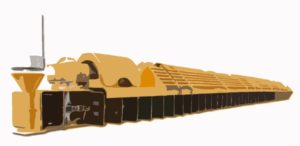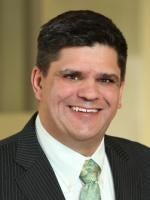A recent order from a patent infringement lawsuit in the Northern District of Illinois serves as a good reminder that factual information about attempts to design around a patent is generally discoverable. This case also distinguishes discoverable factual information from privileged opinion and mental impressions of design-around efforts. In addition, the order suggests “exceptional circumstances” that could be established to “obtain facts or opinions” of design-around efforts from a non-testifying consultant under Federal Rule 26(b)(4).
Background – The Discovery Dispute and Design Around Attempts
Sioux Steel Company sued Prairie Land Millwright Services, Inc. for patent infringement in the Northern District of Illinois (case number 1:16-cv-202212-MMR) alleging that several of Prairie Land’s bin paddle sweep products infringe Sioux Steel’s US Patent No. 8,967,937. Such products are used in the grain industry to empty bins automatically, as shown in the image below.
After the lawsuit was filed, Prairie Land started using one of its existing engineering consultants, Bruce Meyer, as a testifying expert on invalidity. Based on their past consulting relationship, Prairie Land also started using Meyer as a consulting expert to help with design-around modifications to its accused sweep products. Thus, Meyer wore “two hats,” serving as both a testifying expert (on invalidity) and a non-testifying consultant (or design arounds).
Sioux Steel issued Requests for Production to Prairie Land and subpoenaed Meyer to obtain discovery into Prairie Land’s design-around efforts. Prairie Land objected on the basis of work-product and attorney-client privilege. Sioux Steel moved to compel, seeking production of documents containing factual information reflecting Prairie Land’s design-around attempts and to depose Meyer about his work on this issue.

Technical Documents Such as Design Around Schematics are Not Privileged
After a telephone hearing, the Court granted Sioux Steel’s motion to compel in part. In its ruling, the District Court noted that courts “routinely allow discovery into design arounds, notwithstanding that at some level it’s all done ultimately at the direction of counsel and with a view toward litigation,” citing to a Northern District of California order in Illumina Inc. v. BGI Genomics Co., No. 20-cv-01465-WHO (TSH), 2020 U.S. Dist. LEXIS 224965 (N.D. Cal. Dec. 1, 2020).
According to Illumina, “[a]ny modifications defendants have made to the accused products, or any plans defendants have made to modify the accused products, to design around plaintiff’s patents are not privileged or work product.” Illumina explained that “[e]fforts by a defendant to design around a plaintiff’s patent can be relevant to a patent infringement lawsuit in several ways.” For example, “a legitimate attempt to design around a patent and a good faith belief that one has done so may undercut a finding of willfulness.” In contrast, “dragging one’s heels and belatedly attempting a design around only after being sued can support a finding of willfulness.” Further, “an unimplemented but available design around may tilt in favor of issuing a permanent injunction because it can show that the balance of hardships favors an injunction.” Finally, “an unimplemented but available design around can be relevant to damages” such as, for example, being “relevant to the Georgia Pacific factor inquiring into the utility and advantages of the patent property over old modes or devices” or to “show the existence of a non-infringing substitute that undercuts damages.”
Based on Illumina, the Court rejected categorical refusals to allow discovery into design-arounds based on work product and the attorney-client privilege and ordered Prairie Lands to produce all “design modification drawings that appear[ed] on the privilege logs.”
While the Court affirmed that categorical refusals to allow discovery into design-arounds are improper, it did recognize that “actual attorney-client communications about a design around are still privileged, and an attorney written memo with thoughts and impressions about a design around is still work product[,]” again citing to Illumina. After an in camera review of the items listed in Prairie Land’s privilege log, the Court concluded that most of the listed communications did reveal, either directly or indirectly, “the mental impressions and opinions of counsel about litigation issues, or legal advice sought or given on issues in the case” and, therefore, were privileged.
Interestingly, the Court also rejected Sioux Steel’s request that communications and documents exchanged between Prairie Land’s attorneys and its consulting expert, Meyer, be produced in redacted form. Sioux Steel sought to discovery the portions reflecting the mental impressions, opinions, and advice of defense counsel being redacted so that it could “at least learn Meyer’s side of discussions with counsel.” Except for a couple of limited exceptions, the Court rejected Sioux Steel’s request, explaining that the production of such redacted documents “would effectively reveal opinion work product, and in some instances would reveal specific attorney advice that was sought.” Moreover, any factual information contained within the communications is “inextricably intertwined with counsel’s mental impressions and opinions on legal issues in the case, making redaction impracticable.”
Deposition Testimony About Technical Details of a Design Around are Not Privileged
As part of its motion to compel, Sioux Stell also sought to have Prairie Land’s expert, Meyer, re-deposed, so that he could be questioned about his involvement in the design modification process. Sioux Steel claimed that Prairie Land had “categorically prohibited,” during the first deposition, questioning of Meyer regarding his involvement in design modifications.
In deciding this dispute, the Court examined “deposition snippets” flagged by Sioux Steel and found some of Prairie Land’s objections “were well-founded while others were not” and then highlighted some examples of both. As an initial matter, the Court reminded the parties that “[f]actual information is not insulated from discovery simply because it was discussed with counsel or even because the facts came from counsel, relying on the Supreme Court’s 1947 decision in Hickman v. Taylor (329 U.S. 495). The privilege does not protect facts communicated to an attorney,” or allow clients to refuse to disclose facts which their attorneys conveyed to them and which the attorneys obtained from independent sources.
Accordingly, the Court found that Meyer should have answered questions such as the following:
-
“Tell me what potential modifications to the hinge unit you had involvement in?”
-
“Did you ever consider any modifications to that bottom plate that we looked at earlier?”
-
“Has Harvest had any input or involvement with potential design modifications to the sweep, whether they were made or not?”
On the other hand, the Court ruled that the mental impressions, opinions, and advice of Defendants’ counsel were not discoverable without a heightened showing of need and an inability to get the information elsewhere. The Court also noted that depending upon how questions are phrased to the witness, deposition questions may tend to elicit the impressions of counsel about the relative significance of the facts. Opposing counsel is not entitled to an adversaries’ thought processes, and effort must be made to protect against indirect disclosure of an attorney’s mental impressions or theories of the case. At times, Sioux Steel’s questions to Meyer seemed designed to discover opinion work product rather than to avoid it.
For example, the Court confirmed that Prairie Land properly objected to this question:
-
“Were the modifications that you considered to the hinge unit counsel’s idea?”
The Court did not end its analysis there. Rather, the Court went on to make a determination that there were not any “exceptional circumstances under which it [was] impracticable for [Sioux Steel] to obtain facts or opinions on the same subject by other means,” as provided by Federal Rule of Civil Procedure 26(b)(4)(D)(ii). The Court recognized that had Meyer — wearing his “consulting expert” hat — redesigned the bin paddle sweeps for Prairie Land without help from Prairie Land’s employees, Meyer may well have had factual information that would have been highly relevant and unavailable from other witnesses. Had Sioux Steel been able to establish such a showing, it may have met the required “exceptional circumstances” since it would be “impracticable…to obtain facts or opinions on the same subject by other means.”
Takeaways
Care should be taken when supervising attempted design-arounds, as the work may or may not be shielded by the attorney-client privilege or the work product doctrine.
Work done on a design-around that reflects attorney mental impressions or opinions may be protected under the work product doctrine. Communications and documents that reflect such attorney input should be marked Attorney-Client Communication and/or Attorney Work Product to ensure proper treatment during discovery.
Attorneys should be aware, however, that purely factual information about the design-around — including attempts or efforts to design around a patent, and technical documents pertaining to the design-around — are discoverable. This may include factual documents (e.g., design schematics or computer source code) that are attached to otherwise privileged communications.




 />i
/>i
